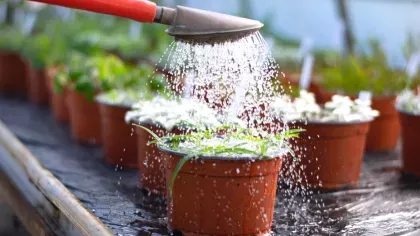1 June 2020
Kyrgyzstan Trial Beds: A step to the Silk Road
Our new trial beds will offer valuable knowledge for the creation of a spectacular future attraction at Wakehurst.

Our new Kyrgyzstan Trial Beds are the start of an exciting and big new project at Wakehurst – the creation of a Silk Road Steppe landscape.
Inspired by the plant life along the Silk Road, an ancient trading route that connects China to the West, our new landscape will be brimming with wild-collected flora native to this Central Asian region, including Kyrgyzstan.
Our current Asian Heath Garden will be transformed to incorporate our beautiful and immersive Silk Road Steppe, with its stunning array of plants.
But before that gets underway, we’re doing a bit of testing to help us prepare.

What are the trial beds?
Kyrgyzstan is a country with amazing wildflowers and native plants.
Our horticulturists here at Wakehurst are trialling different plants from Kyrgyzstan for the new attraction.
Using an area in the Asian Heath Garden, we are exploring how we turn Kyrgyzstan’s meadow plant communities into garden design, figuring out the best planting solutions and how to get the most from our environment.
We have 10 plant beds, five on each mirrored side and each plot measuring four by four metres.
Each side tests a different recommended seed mix ratio between emergents (taller plants) and base layer (smaller plants) to see how well they grow and knit together as a mini plant community.
On the one side, the ratio between these two types of plants is an equal 50:50. Whereas, the opposite side has 70% base layer to 30% emergents.
These trial beds are also allowing us to test various mulch layers and thicknesses, and work out which type and depth of soil we should use for our Silk Road Steppe.
Gravel mulch and sand mulch are being used, along with ordinary Wakehurst earth as a control.

Plant picks
As part of the Millennium Seed Bank’s Kyrgyzstan conservation programme, a small team of our scientists and horticulturists went to Kyrgyzstan on a field trip in 2017.
They researched the country’s flora and surveyed populations of flowering target species.
Seeds were also collected for conservation in the Millennium Seed Bank and to be grown in our trial beds.
More than 3,500 individual plants of 25 different species have been planted in the beds for the Silk Road Steppe. These include:
- Salvia deserta
- Stipa pulcherrima var. nudicostata
- Delphinium iliense
- Tulipa greigii 'Red Riding Hood'
- Achillea filipendulina ‘Gold Plate'
- Allium carolinianum 'Rosy dream'
- Echinops knorringianus
- Echinops nanus
- Melica ciliata
- Tulipa kaufmanniana 'Johann-Strauss'
- Veronica spuria
- Eremurus robustus
- Erigeron aurantiacus



The ‘death bed’
The trial beds are in an area of the Asian Heath Garden which used to be the Sino-Himalayan bed.
It was ominously nicknamed the ‘death bed’ due to its poor drainage and compacted soil.
But after giving the bed a fallow year, rotovating, aeration, and adding the mulch layers for the trial, this has improved.
It is vital that the soil for our Silk Road Steppe has low fertility and is as impoverished as possible to reduce competitiveness among other plant species.

What's next?
We are monitoring the flowering plants in the beds and we’re already seeing some exciting results.
Some of the aspects we are assessing are the frequency of weeds, cutting and maintenance techniques, a monthly vegetation establishment survey of the plots, and the success of the mulch and ratio seed mixes.
We are also taking notes on specific species and carrying out photographic monitoring.
So, what’s next?
We plan to collect more wild plant species for the Kyrgyzstan trials.
The information we gather here will help inform the creation of our Silk Road Steppe, and make sure our Central Asian flowers and plants will flourish in our gardens.


.jpg.webp?itok=82idE9Th)
